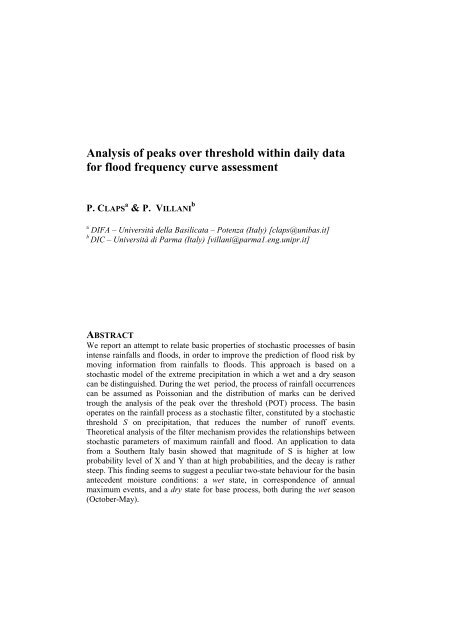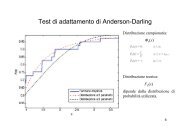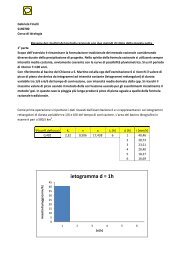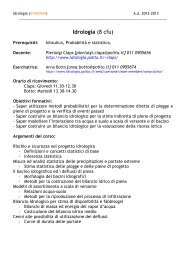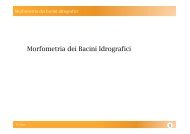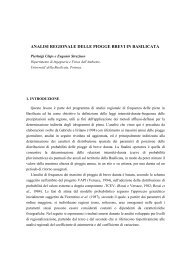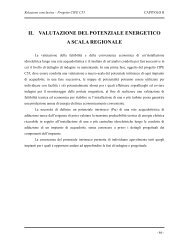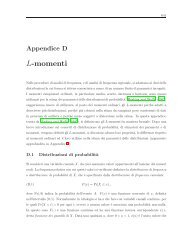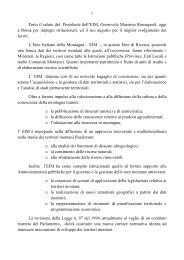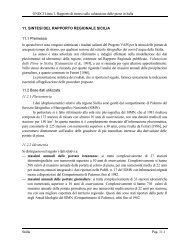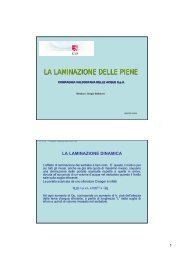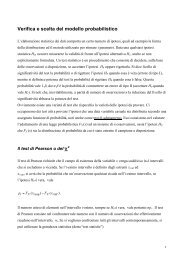Analysis of peaks over threshold within daily data ... - idrologia@polito
Analysis of peaks over threshold within daily data ... - idrologia@polito
Analysis of peaks over threshold within daily data ... - idrologia@polito
You also want an ePaper? Increase the reach of your titles
YUMPU automatically turns print PDFs into web optimized ePapers that Google loves.
<strong>Analysis</strong> <strong>of</strong> <strong>peaks</strong> <strong>over</strong> <strong>threshold</strong> <strong>within</strong> <strong>daily</strong> <strong>data</strong>for flood frequency curve assessmentP. CLAPS a & P. VILLANI ba DIFA – Università della Basilicata – Potenza (Italy) [claps@unibas.it]bDIC – Università di Parma (Italy) [villani@parma1.eng.unipr.it]ABSTRACTWe report an attempt to relate basic properties <strong>of</strong> stochastic processes <strong>of</strong> basinintense rainfalls and floods, in order to improve the prediction <strong>of</strong> flood risk bymoving information from rainfalls to floods. This approach is based on astochastic model <strong>of</strong> the extreme precipitation in which a wet and a dry seasoncan be distinguished. During the wet period, the process <strong>of</strong> rainfall occurrencescan be assumed as Poissonian and the distribution <strong>of</strong> marks can be derivedtrough the analysis <strong>of</strong> the peak <strong>over</strong> the <strong>threshold</strong> (POT) process. The basinoperates on the rainfall process as a stochastic filter, constituted by a stochastic<strong>threshold</strong> S on precipitation, that reduces the number <strong>of</strong> run<strong>of</strong>f events.Theoretical analysis <strong>of</strong> the filter mechanism provides the relationships betweenstochastic parameters <strong>of</strong> maximum rainfall and flood. An application to <strong>data</strong>from a Southern Italy basin showed that magnitude <strong>of</strong> S is higher at lowprobability level <strong>of</strong> X and Y than at high probabilities, and the decay is rathersteep. This finding seems to suggest a peculiar two-state behaviour for the basinantecedent moisture conditions: a wet state, in correspondence <strong>of</strong> annualmaximum events, and a dry state for base process, both during the wet season(October-May).
2 STOCHASTIC MODEL OF PEAK OCCURRENCES2.1 – Mechanism <strong>of</strong> peak occurrencesFrom the analysis <strong>of</strong> peak occurrences in basins <strong>of</strong> the Mediterranean area itresults evident that this stochastic process is not homogeneous in time. A firstbasic distinction can be made observing the process patterns in two differentclimatic seasons: a dry season during the summer period, and a wet seasonotherwise (Figure 1). This approximation looks reasonable and parsimonious asa starting point (see also Sirangelo, 1994).As said above, we assume a Poissonian scheme for modelling timeoccurrences <strong>of</strong> flood <strong>peaks</strong> during the wet season, based on the observation thatthe exponential probability distribution <strong>of</strong> the inter-arrival time <strong>of</strong> the <strong>peaks</strong> canbe valid as a first approximation. If necessary, one could also distinguish a finertime structure during the wet season.35Alento30<strong>daily</strong> run<strong>of</strong>f <strong>peaks</strong> (mm)25201510500 2 4 6 8 10 12 14 16 18 20 22 24time in monthsFigure 1. Process <strong>of</strong> occurrence <strong>of</strong> <strong>peaks</strong> <strong>of</strong> mean <strong>daily</strong> discharge.2.2 – Probability distribution <strong>of</strong> <strong>peaks</strong>As a consequence <strong>of</strong> the Poissonian hypothesis, if Λ(x) is the mean annualnumber <strong>of</strong> peak occurrences <strong>over</strong> a <strong>threshold</strong> <strong>of</strong> magnitude x and Λ(x o ) is the
analogue for a value x o low enough to have a cumulative probability F X (x o ) ≈ 0,but high enough to allow the Poissonian hypothesis to be valid, then thefollowing relationship holds (see e.g. Çinlar, 1975, p. 94]Λ(x)/Λ(x o ) = 1 – F X (x) ( x ≥ x o ) (1)where F X (x) is the cumulative distribution function (CDF) <strong>of</strong> the random variateX. In practice, the importance <strong>of</strong> the choice <strong>of</strong> x o decreases as much as Xbecomes high enough to consider valid the Poissonian hypothesis onoccurrences.2.3 Statistical relation between rainfall and discharge POT processesLet us consider:X = total rainfall depth in 1 day, <strong>over</strong> the basin (in mm);Y = total discharge volume in 1 day, from the basin outlet (in mm).We assume Y to be the result <strong>of</strong> a deterministic/stochastic filter operated by thebasin <strong>over</strong> the stochastic process <strong>of</strong> the <strong>daily</strong> rainfall. The transformation weconsider is a simple non-linear, <strong>threshold</strong> model asY = 0 if X ≤ SY = g(X−S; α)otherwise(2)where g(•;α) is a general transformation function, that depends on theparameter vector α, and contains information on the basin characteristics. Filterparameters S and α can be both deterministic and stochastic. As a firstapproximation, we consider the basin characteristics α as deterministic, whilethe filter <strong>threshold</strong> S can take into account the stochastic state <strong>of</strong> the systempreceding the intense rainfall generating the flood <strong>peaks</strong>.Based on these assumptions, discharge <strong>peaks</strong> will be considered equivalentto <strong>over</strong>-<strong>threshold</strong> rainfalls (Y=X−S), producing a relationship between theannual rate <strong>of</strong> flood <strong>peaks</strong> Λ Y and rainfall <strong>peaks</strong> Λ X <strong>of</strong> the type <strong>of</strong> eq. (1), thatgives here the probability <strong>of</strong> the (external) filter <strong>threshold</strong> S:Λ Y = Λ X [1 – F X (S)] (3)Eq. (3) indicates that, for any transformation function g(•;α), the meanannual number <strong>of</strong> flood peak occurrences can be derived through the knowledge<strong>of</strong> the probability distribution <strong>of</strong> rainfall <strong>peaks</strong> F X (•) and <strong>of</strong> the mean annualnumber <strong>of</strong> rainfall peak occurrences, given a state <strong>of</strong> the system, i.e. a value <strong>of</strong>S. Both Λ Y and Λ X have a probabilistic structure that depends on the <strong>threshold</strong>
level, as shown in (1). The control operated by the <strong>threshold</strong> filter S on thetransformation processes will be then inferred by the ratio <strong>of</strong> the empiricaloccurrence parameters Λ Y and Λ X computed through POT analysis. Inparticular, using historical records <strong>of</strong> areal <strong>daily</strong> rainfall and <strong>of</strong> mean <strong>daily</strong>discharges we will show how it is possible to characterise the probabilitydistribution <strong>of</strong> S and the relative role that its stochastic variability plays inproducing high flood <strong>peaks</strong>.3 POT ANALYSIS AND CASE STUDY3.1 Criteria for identification <strong>of</strong> <strong>peaks</strong>On <strong>daily</strong> discharge records, consecutive and different peak occurrences (inthe statistical sense <strong>of</strong> independence) must be suitably identified. To this end, astandard procedure adapted from the Matlab © library, namely the find<strong>peaks</strong>function [The Mathworks] was applied to run<strong>of</strong>f records, leading to theselection <strong>of</strong> isolated <strong>peaks</strong> (see Figure 2). <strong>Analysis</strong> <strong>of</strong> interarrival times duringthe wet season (Figure 3) showed that additional filtering was not necessary, atleast at the present stage <strong>of</strong> analysis.15Alentoavg. <strong>daily</strong> discharge (mc/s)10502900 2950 3000 3050 3100 3150 3200 3250 3300 3350time in daysFigure 2. temporal process <strong>of</strong> peak discharge occurrence
10 0 Alento1-Cumulative Probability10 -110 -20 50 100 150Interarrival time (days)Figure 3. Probability distribution <strong>of</strong> the inter-arrival time <strong>of</strong> discharge peak occurrencesduring the wet season: estimates (circles) and fitted exponential distribution (dots).3.2 Relation between filter <strong>threshold</strong> S and probability <strong>of</strong> the eventsTo identify the statistical relationship between stochastic filter <strong>threshold</strong>S and probability <strong>of</strong> the peak event we used the following procedure(graphically represented in Figures 4a and 4b):(i)(ii)(iii)Given a probability 1 – F X (X) for rainfall <strong>peaks</strong>, Λ o ⋅Λ X /Λ o gives anoccurrence level Λ X and a corresponding <strong>threshold</strong> X (Fig. 4a).Since (3) is valid, we search a value <strong>of</strong> the discharge peak Y such thatΛ X = Λ Y = Λ (Fig. 4b).The difference between X and Y values taken at the same Λ representsthe estimate <strong>of</strong> S X corresponding to the probability 1 – F X (X).
10 0 Alento1-F(X)(a)10 -1Λ/Λ010 -210 -3X0 10 20 30 40 50 60rainfall <strong>threshold</strong> (mm)Alento10 2 <strong>threshold</strong> (mm)(b)rainfallrun<strong>of</strong>f10 1S(X)Λ10 0X0 10 20 30 40 50 60Figure 4. Sketch <strong>of</strong> the procedure <strong>of</strong> deriving the statistical relationship between the<strong>threshold</strong> S and the probability <strong>of</strong> the rainfall peak.
3.2 Basin description and application <strong>of</strong> the procedureAreal rainfall and discharge <strong>data</strong> from a basin located in southern Italy havebeen analysed. The basin belongs to the Alento river, in Campania, has an area<strong>of</strong> 285 Km 2 and presents only a very small fraction <strong>of</strong> carbonate formations, soto allow us to classify it as almost completely impermeable. Based on the basinarea, order <strong>of</strong> magnitude <strong>of</strong> discharges can be determined from the figuresbelow considering that 1 mm <strong>of</strong> equivalent discharge measures about 3.3 m 3 /s.On the basin under study 13 years <strong>of</strong> <strong>daily</strong> average discharge and 20 years <strong>of</strong><strong>daily</strong> rainfall were available. All <strong>of</strong> the figures presented above are referred tothese hydrological records.The procedure discussed in the above paragraph was applied to the curves <strong>of</strong>Λ(X) (figure 4) obtained for different <strong>threshold</strong>s on rainfalls and discharges.Applying the proposed procedure for probability levels ranging from 0.1 to<strong>over</strong> 0.99 we obtained the curve represented in Figure 5 , that shows a peculiarrelationship between the probability level F <strong>of</strong> the rainfall and the stochastic<strong>threshold</strong> S <strong>of</strong> the basin. Note that using the representation in terms <strong>of</strong> 1-F, inreverse scale, provides a correct viewpoint in terms <strong>of</strong> recurrence intervalincreasing toward the right part <strong>of</strong> the scale.16Alento151413S (mm)12111098710 010 -110 -210 -31-F(X)Figure 5. Statistical relationship between the <strong>threshold</strong> S and the probability <strong>of</strong> therainfall peak for the Alento river
In the figure we can distinguish different zones:i) very low value <strong>of</strong> F (non-Poissonian zone): we disregarded values obtainedfor F0.99)the basin <strong>threshold</strong> S is relatively constant and low, being 8 mm, that is lessthan 60% <strong>of</strong> the value assumed in the dry state;iv) intermediate value <strong>of</strong> F (transition phase): during this phase the <strong>threshold</strong>S is not a constant and must be considered a stochastic variable.Based on this result, it seems possible to identify a two-state pattern thatcharacterises the system transformation in dependence <strong>of</strong> the probability level<strong>of</strong> rainfalls and floods.4. FINAL DISCUSSIONIn order to identify the mechanism leading to flood peak distribution Ystarting from rainfall peak distribution X, we considered a general framework inwhich the basin is a deterministic filter that operates through a stochastic<strong>threshold</strong> parameter S.We did not address the theoretical derivation <strong>of</strong> the distribution <strong>of</strong> Y thatconsiders the joint probability distribution <strong>of</strong> X and S. This distribution isdifficult to derive from usual hydrological information, because the analyticalapproach has to face the dependence <strong>of</strong> S on antecedent moisture condition.Our alternative approach is based on peak <strong>over</strong> <strong>threshold</strong> (POT) analysis <strong>of</strong><strong>daily</strong> rainfall and discharge: under the simple, but realistic assumption <strong>of</strong>Poissonian occurrence <strong>of</strong> <strong>peaks</strong>, we showed how it is possible to derive arelationship between the magnitude <strong>of</strong> S and the probability level <strong>of</strong> X and Y.Previous analyses considered only the annual maximum series (AMS) <strong>of</strong><strong>daily</strong> rainfall and flood: Ferrari et al. [1993] considered the ratio Λ Y / Λ X , thatcan be considered a surrogate <strong>of</strong> S, only as a deterministic parameter <strong>of</strong> thebasin response, constant <strong>over</strong> a climatic region. Recently, an attempt was madeto explain the observed spatial variability <strong>of</strong> that ratio taking into account thepermeability characteristic <strong>of</strong> the basin and a surrogate <strong>of</strong> the antecedent soilmoisture condition considered constant and related to the Thorntwaite annual
climatic index [Iacobellis et al., 1998]: no estimation <strong>of</strong> the probability levelassociated with this ratio can be made, because <strong>of</strong> the use <strong>of</strong> the AMS. Thepresented procedure, taking the advantage <strong>of</strong> using the POT techniques <strong>of</strong> <strong>daily</strong>rainfall and discharge, is the first attempt to explicitly estimate the relative roleplayed by deterministic and stochastic parameter <strong>of</strong> the basin, in transformingheavy rain into flood peak discharge.An application to a case study in a Southern Italy basin has shown a peculiarprobabilistic structure <strong>of</strong> S: the magnitude <strong>of</strong> S is higher at low probability level<strong>of</strong> X and Y than at high probabilities, and the decay is quite steep. This findingsseems to suggest a peculiar two-state behaviour for the basin antecedentmoisture conditions: a wet state, in correspondence <strong>of</strong> annual maximum events,and a dry state for base process. It is important to consider that both states werefound during the wet season (October-May). Other authors found a two-statebasin behaviour, but in two different seasons (e.g. Grayson et al., 1997).Such a mechanism could explain some extraordinary flood eventsexperienced in the past in the same region <strong>of</strong> the case study and not justified byextraordinary rainfall <strong>peaks</strong>: inundations could have been produced by acombination <strong>of</strong> high rainfall peak and extraordinary wet condition <strong>of</strong> the basin,represented by a very low value <strong>of</strong> S. Further investigations are needed toevaluate the possibility that POT give information useful for the separationprocess.Identification <strong>of</strong> the probability structure <strong>of</strong> S can be made in terms <strong>of</strong>: (i)magnitude characterising wet and dry state; (ii) magnitude <strong>of</strong> differencebetween the two states (or jump), and (iii) location, in probability, <strong>of</strong> the breakpointsbetween the two states. The ensemble <strong>of</strong> information resulting on S havesuggested the possibility <strong>of</strong> a regionalization <strong>of</strong> the proposed procedure, whosegoal is the consideration <strong>of</strong> this stochastic parameter as a function <strong>of</strong> basinhydro-geological characteristics: to this aim, further investigation are needed, inorder to extend the different environments in which the procedure can beapplied and to test and, eventually, relax, the base hypotheses <strong>of</strong> Poissonianprocesses.6. REFERENCESBierkens, M.F. P. and C. E. Puente, Analytically Derived Run<strong>of</strong>f Models Basedon Rainfall Point Processes, Water Resour. Res., 1990, vol. 26, no. 11, pp.2653-2665.Çinlar, E., Introduction to Stochastic Processes, Prentice-Hall, Inc., EnglewoodCliffs, N.J. (USA), 1975, pp. 402.Iacobellis, V., Claps, P., & Fiorentino, M. (1998) Sulla dipendenza dal clima deiparametri della distribuzione di probabilità delle piene, Proc. XIV Conf di
Idraulica e Costruzioni Idrauliche, vol II, 213-224, CUECM, Italy, (inItalian).Ferrari, E., S. Gabriele and P. Villani, Combined regional frequency analysis <strong>of</strong>extreme rainfalls and floods, 6th IAHS/IAMAP Symp., Yokohama (Japan),1993.Grayson R.B., A.W. Western and F.H.S. Chiew, Preferred states in spatial soilmoisture patterns: local and non-local controls, Water Resour. Res., 1997,vol. 33, no. 12, pp. 2897-2908.Lang, M., T.B.M.J. Ouarda and B. Bobée, Toward operational guidelines for<strong>over</strong>-<strong>threshold</strong> modeling, J. Hydrol., 225, 1999, pp. 103-117.Sirangelo, B., Un modello Poissoniano non omogeneo per l’analisi delleprecipitazioni cumulate su lunghi intervalli temporali, Idrotecnica, 3, 1994,pp. 125-158.Sirangelo, B. and G. Iiritano, I processi puntuali nello studio delle occorrenzadelle precipitazioni intense, L’Acqua, 6, 1999, pp. 35-60.The MathWorks, Natick, MA (http://www.mathworks.com).Todini, E., The ARNO rainfall-run<strong>of</strong>f model, J. Hydrol., 175, 1996, pp. 339-382.


